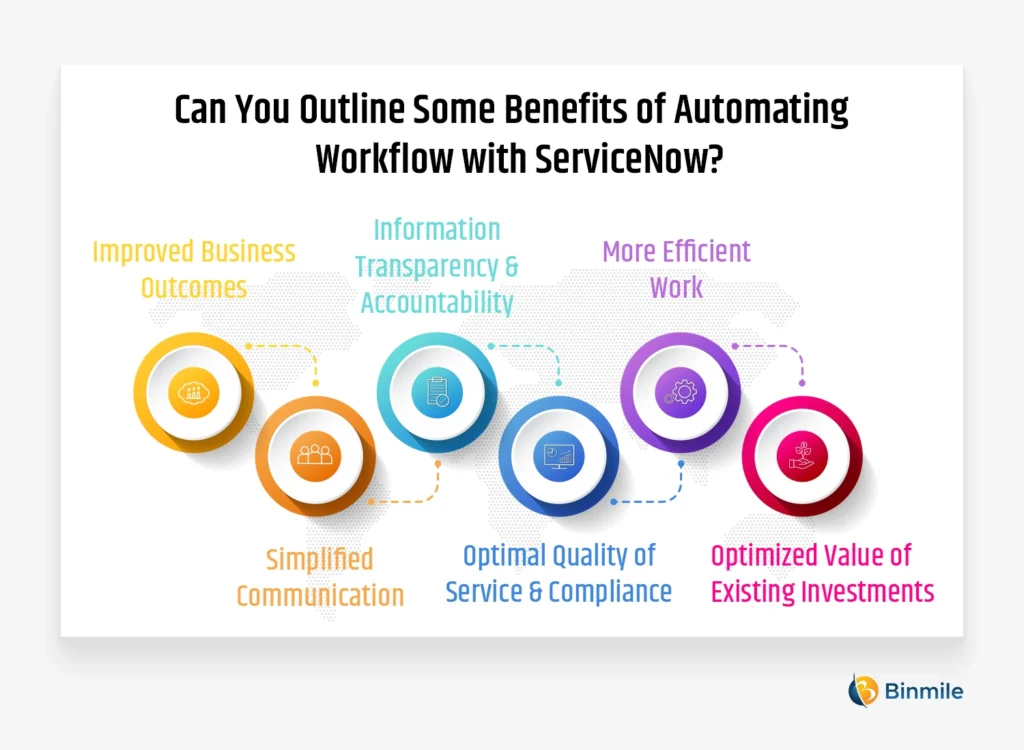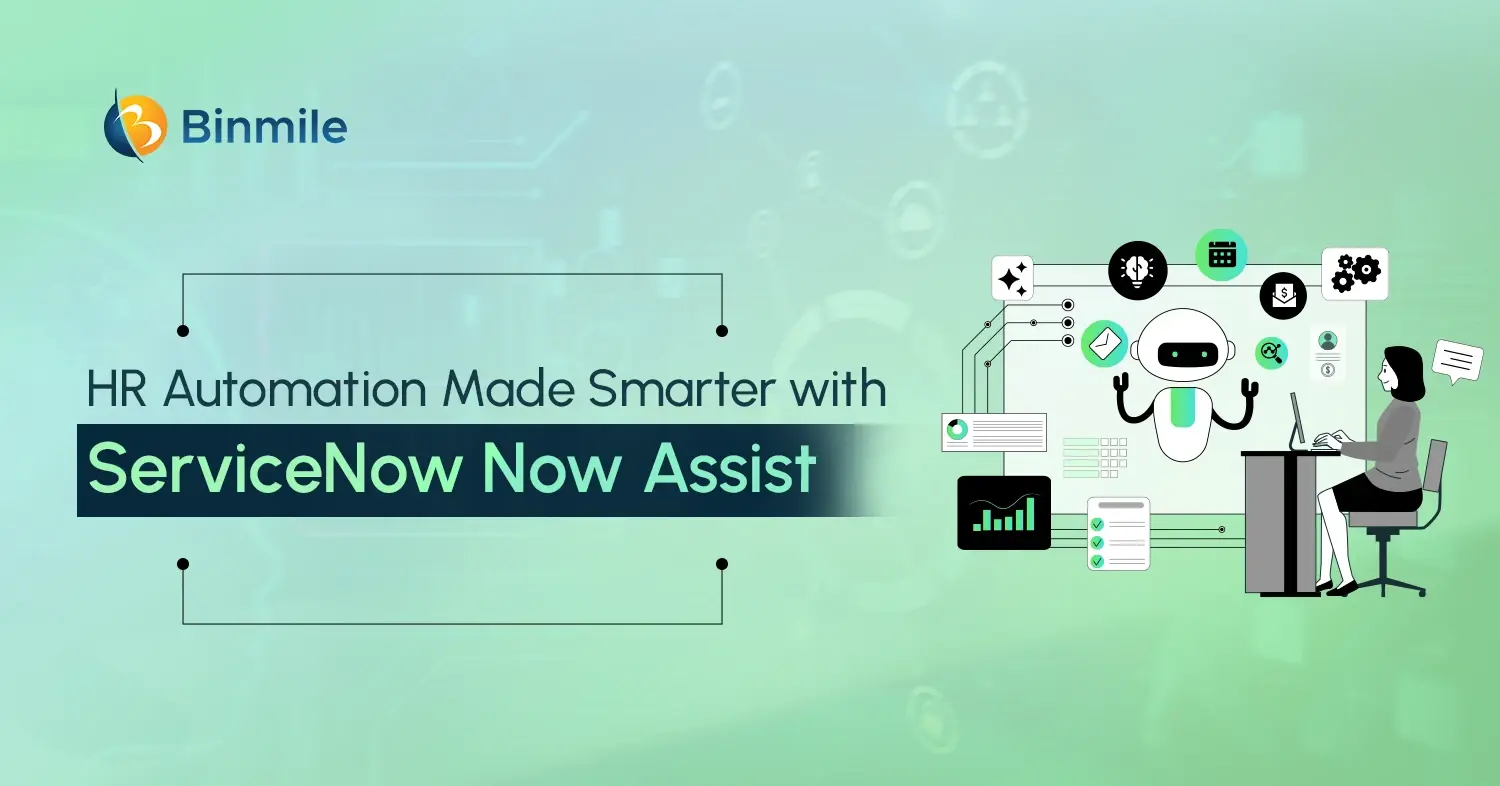Do you know that the internal operations of your business have a lot to do with your efficiency, productivity, and most importantly, your customers’ experiences? Yes, the smoother they are, the better the results they can deliver. Not just that! You can also get rid of paper forms to process simple requests, be it assigning a set of devices to a new employee or getting approvals from seniors for certain tasks. But all this can be feasible only when you automate the entire workflow with ServiceNow.
Be informed, the way you engage with your personnel, consumers, and other stakeholders is key to staying ahead in today’s digital world. And to deliver an enticing and interactive experience to modern users, it is necessary to automate your internal and external workflows as soon as possible. That’s where the role of ServiceNow becomes so important.
What else? Although data collection and analysis can assist IT service providers in investigating trends, preventing threats, and delivering more proactive services, it is data-driven automation that can enable professionals to eliminate routine tasks from their pipeline and concentrate on value-adding services. This clearly indicates how imperative it is to automate your workflow with ServiceNow if you want to reap the maximum benefits of your employees’ abilities. In fact, according to the world’s largest news distribution network, the industrial automation services market is predicted to expand from USD 147.06 Billion in 2019 to USD 264.69 Billion by 2026. Now, let’s get a glimpse of:
What is a Workflow?

In order to get a good sense of workflow, you must first understand the hierarchy of business activities. The basic unit of any work is a task. A task is a single assignment or a single action taken toward accomplishing an organizational goal within a set duration of time. And when multiple tasks are combined together, they create processes. Finally, when various processes are merged to attain a specific business outcome while including wads of employees, they are called workflows, which can be within IT service management or other areas out there.
Some solid examples of workflow are:
- New employee onboarding
- Document approvals
- Authorization request
- Purchase orders
- Help-desk tickets
- Customer feedback processing
- Objectives planning
What is the Deal with Automating Workflow with ServiceNow?
Workflow automation refers to the use of software to independently handle the flow of tasks and data in accordance with business rules, making it feasible to:
- Streamline processes
- Decrease manual work
- Improve operational efficiency
What is ServiceNow’s Approach to Automated Workflows?
ServiceNow Workflow Automation is a robust tool for establishments looking to streamline their business processes and enhance efficiency. The ability to automate workflow with ServiceNow can hugely reduce the time and effort required to complete various tasks, eventually releasing precious resources to perform more critical activities.
What’s more? ServiceNow’s approach to customer service management eliminates bottlenecks and incorporates processes and activities between individuals and systems. Also, the interactions that include forms, requests, events, and approvals can be simplified with automated workflows with the help of a drag-and-drop interface. Activities can encompass everything from generating records and informing users of pending approvals to running scripts, tasks, timers, and more. Above all, you can build end-to-end automation of previously disconnected processes that help operate your business.
Can You Outline Some Benefits of Automating Workflow with ServiceNow?

1. Improved Business Outcomes
Having the intention to grow business with ServiceNow, you will be glad to know that this cloud computing platform can automate the routing of requests, decisions, approvals, and actions, resulting in expediting various tasks and outcomes.
Wondering how? Take, for instance, a critical incident raised for Binmile Technologies regarding an issue with their network access. An SMS notification is sent to Alex, a support engineer, who is currently in charge of this type of incident. However, he is not available and does not answer within the first slot of 30-minute response time. Then, the automated workflow with ServiceNow acts based on rules defined for Binmile’s critical incidents and performs an escalation post 30 minutes without a response. The person defined as the next point of contact in such cases is Mary, Alex’s line manager, so an SMS notification is sent to her, who further resolves the problem.
2. Simplified Communication
Getting an automated workflow at your disposal means you can leverage a simple, streamlined communication process where you can see all your requests in one place. No long email threads or sticky notes are required to track different tasks.
3. Information Transparency & Accountability
Just to let you know, when you automate workflow with ServiceNow, you assign an in charge for each step of the process. Be it initiations, rejections, approvals, or input, all are associated with just one individual. This enables information transparency in your processes and enforces responsibility.
4. Optimal Quality of Service & Compliance
Carrying out digital transformation with ServiceNow further mitigates errors and monitors and audits end-to-end performance. Some errors that can prove to be extremely expensive down the line are:
- Late payments
- Slow sales approvals
- Payments for goods not received
Once you decide to leverage the potential of ServiceNow automation, you can see the real-time update of any task and make sure that these pricey mistakes are avoided.
5. More Efficient Work
By utilizing workflow with ServiceNow, you can get rid of unnecessary steps and processes and incorporate disconnected processes. A case in point here is that by using automated workflows, common threats and attacks can easily be recognized and removed, thus allowing your data security team to monitor advanced and more complicated attacks.
6. Optimized Value of Existing Investments
Last but not least, ServiceNow ITBM comes in handy in incorporating existing applications and data. With its help, you can address new use cases and requirements and enhance existing workflows.
Once you have automated your workflow with ServiceNow, you get deeper insights into:
- How many requests came in?
- How many of them were approved?
- How many of them were rejected?
- How long did each request take for fulfillment?
- And many more things as such
This way you will be able to know where exactly the bottleneck is and can take plunges to remove the same.
How can a Reliability Platform Help in Automating Workflow with ServiceNow?
The key to automated workflow with ServiceNow is its potential to incorporate with third-party applications, be it web-based or on-premise. By making the most of SynQ’s drag-and-drop interface, you can incorporate ServiceNow with any enterprise application without typing a single piece of code. In short, SynQ facilitates real-time and batch integration processes for organizations.
In case you don’t know what SynQ is, we must tell you that it is a reliability platform for business-critical data that turns out to be useful for:
- Error detection
- Incident management
- Ownership
- Resolution workflows
This offers data teams a toolkit as good as tools exploited by software engineers.
The Endnote
The advantages of automating workflow with ServiceNow are many, especially if you want to foster transparency, accountability, and ownership of every service request within your organization. Not just that! You will be informed about each step of the process a request goes through and can commit exact time to your loyal customers for their desired service delivery.
Thus, if you are impressed with this content and want to enhance enterprise value with ServiceNow, it is in your best interest to partake in a consultation process with SN experts at Binmile. We would love to work on your service requests, especially those related to ServiceNow projects.
Frequently Asked Questions
A business analyst (BA) plays a crucial role in bridging the gap between business stakeholders and technical teams by analyzing business processes, identifying needs, and translating requirements into actionable solutions. BAs act as facilitators, communicators, and problem-solvers, ensuring that projects align with business objectives and deliver value to stakeholders.
Business process automation (BPA) can significantly improve business analysis by streamlining workflows, enhancing data accuracy, and providing valuable insights into business processes. BPA enables business analysts to focus on higher-value activities such as strategic analysis, decision-making, and innovation by automating routine tasks and facilitating faster, more informed decision-making.
Improving business workflows involves optimizing and refining the sequence of tasks, activities, and processes within an organization to enhance efficiency, productivity, and effectiveness. It entails identifying bottlenecks, streamlining operations, and implementing changes to streamline processes, reduce manual effort, and achieve better outcomes.









